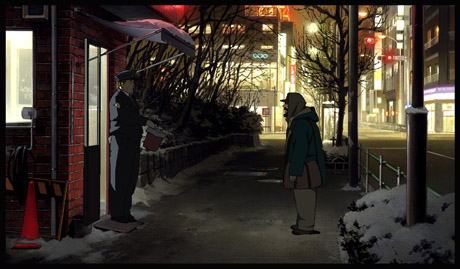
Shout Factory!/Gkids’ re-release of Tokyo Godfathers (2003) — with an English dub for the first time — serves as a reminder of the exceptional talent the art of animation lost when Satoshi Kon died in 2010 at the age of 46.
Tokyo Godfathers was his third feature, after Perfect Blue (1998) and Millennium Actress (2002). In a 2003 interview, Kon cited John Ford as a director he admired, and the film reflects the influence of Ford’s 3 Godfathers (1948). But Kon’s “godfathers” are very different from Ford’s hard-bitten rustlers.

Hana is a flamboyant ex-drag entertainer; Gin, an alcoholic who claims he used to be a bicycle racer; Miyuki, a sullen teenage runaway. This scruffy trio scratches out a living in the alleys of Shinjuku. (The massive towers of the Tokyo municipal government building loom over their cardboard shack). Their already tenuous existence turns chaotic when they discover an abandoned baby in a trash heap on Christmas Eve.
Unlike the cheery trios in American animated features—Anna, Elsa and Kristoff in Frozen or Shrek, Donkey and Fiona in the Shrek films—Hana, Gin and Miyuki scream and sob as they confront the lies about their pasts they’ve told each other–and themselves. They rummage through trash cans and steal whiskey left as offerings in graveyards.
Yet they remain curiously endearing and even noble in their way. All three care deeply about the infant Hana names Kiyoko. And they love each other, although they’d be loath to admit it. Kon shows that battling the inner demons that brought the characters to skid row can be more daunting than fighting an exterior foe.
Many anime directors have presented science fiction films in dystopic future slums. But the contemporary setting of Tokyo Godfathers clashes with the popular image of Tokyo as the cleanest and most affluent of cities.

As he did in Millennium Actress, Kon skillfully uses a palette of subdued grays, greens, and blues to suggest the bitter winter cold. (“Doesn’t it know how to do anything but snow,” Hana grumbles). The washed-out colors also reflect the alienation of the characters from a society that ignores them. Like urban ghosts, they move through the streets of Tokyo, receiving scant attention from more comfortable passers-by.
“I didn’t choose homeless people to be heroes. They’re messengers,” Kon explained. “The image of these socially disadvantaged people, who are living their lives vitally and fully, should make viewers less anxious about the troubles, worries and discontents of everyday life.”
The original cast featured Aya Okamoto as Miyuki, Toru Emori as Gin and Yoshiaki Umegaki as Hana. The English dub has Victoria Grace as Miyuki, John Avner as Gin and Shakina Nayfack as Hana. The new cast is satisfactory, and allows English-speaking audiences to watch the film without subtitles detracting them from the visuals. But audiences can hear the whiskey and cigarettes more clearly in Emori’s voice, and Umegaki gives Hana exaggeratted riffs that better match the animation. In the Los Angeles Times, Manohla Dargis wrote of his Hana, “she just opens her mouth and a voice rumbles out like a Mack truck.”
When the film was released in America, some critics argued it would be more appropriate to present this realistic tale in live action. Kon disagreed, saying, “I’ll probably never make a live action feature. Animation is the perfect form to realize my ideas about movies. I can express my thoughts and ideas clearly and in detail: The realistic essence of drawings makes them the ideal way to present information to an audience.”
Seventeen years later, his words still ring true. And the worsening homelessness crisis has only given Tokyo Godfathers a greater immediacy.
Tokyo Godfathers
Shout Factory!/Gkids: $14.95 2 discs, DVD and Blu-ray
- REVIEW: “Haikyu!! The Dumpster Battle” - July 2, 2024
- Charles Solomon’s Animation Year End Review 2023 - December 28, 2023
- INTERVIEW: Makoto Shinkai on “Suzume” - November 27, 2023


 June 17th, 2020
June 17th, 2020  Charles Solomon
Charles Solomon  Posted in
Posted in  Tags:
Tags: 






